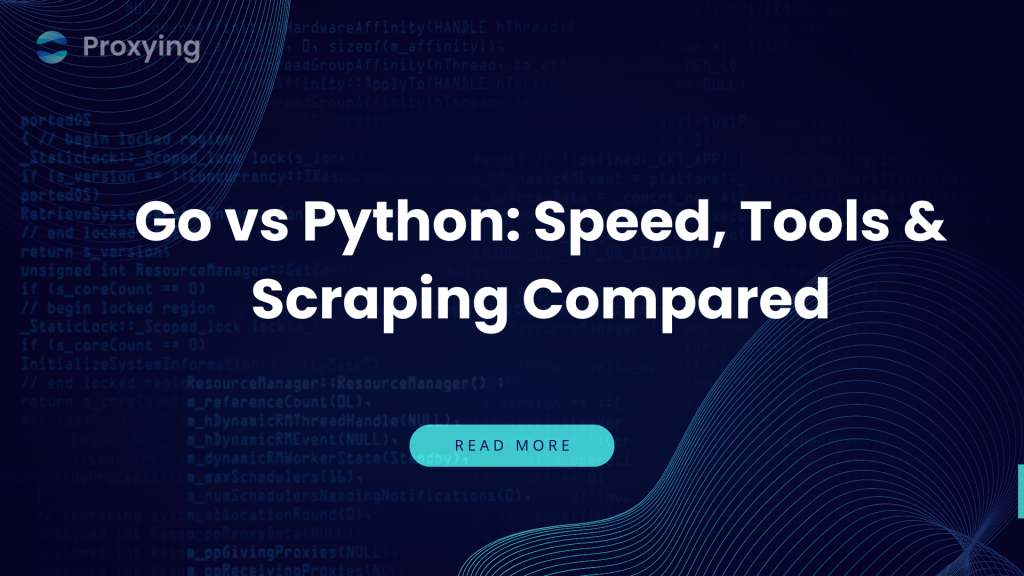Talking about the selection of the proper programming language to use when doing web scraping, automation, and backend, two candidates seem to appear the most frequently: Go (or Golang) and Python. Both languages are rich in terms of their communities and are suitable for several purposes, yet they have different problems.
This blog is going to dissect “Go vs. Python” on performance, ease of use, libraries, concurrency, and scraping potential. This guide will enable you to make a better decision on whether to create highly performant scrapers or maintain a scalable proxy infrastructure.
Go vs. Python: A Quick Overview
| Feature | Go | Python |
| Syntax | Statically typed, verbose | Dynamically typed, concise |
| Speed | Compiled very fast | Interpreted, slower |
| Concurrency | Built-in (goroutines) | External libraries (asyncio) |
| Learning Curve | Moderate | Beginner-friendly |
| Scraping Tools | Fewer Library Options | Rich ecosystem (BeautifulSoup, Scrapy, Requests) |
| Deployment | Simple binaries | Requires dependencies/runtime |
| Use Cases | High-performance tools | Rapid development, data science, and scraping |
Python
This is normally the default language used when scraping web pages, and rightly so. It comes with its ecosystem of libraries optimized to work with HTML DOM, HTTP requests, and browser automation.
Strengths of Pythons:
- Rich libraries: Scraping is simple with requests, BeautifulSoup, Scrapy, and Selenium.
- Quick prototyping: Python syntax is simple and so you can implement scrapers fast.
- Large community: Tons of tutorials, community aid, and third-party tools.
Limitations:
- Slower performance: Not perfect in CPU-intensive jobs and massive scraping.
- Limited concurrency: Python has a Global Interpreter Lock (GIL), which limits actual multithreading, so it is not ideal when it comes to execution in parallel
Python is the most appropriate whenever the developer needs to launch scraping projects at speed, particularly when used in conjunction with proxies, which deter IP blocks, up to the scale of encountering issues with connections. If you encounter errors in Python, you may see the “What Is a Syntax Error in Python” guide.
Go
Go is a statically typed compiled language developed by Google. It’s known for its simplicity, speed, and built-in concurrent model.
Strengths of GO:
- High Performance: Go with goroutines and channels works great when it comes to parallelized scraping.
- Excellent concurrency: Go with goroutines and channels works great when it comes to parallelized scraping.
- Easy development: It is easy to construct standalone binaries with zero external dependencies.
Limitations
- Smaller scraping ecosystem: Libraries such as Colly, GoQuery, and Rod are available, but are not as developed as those of Python.
- Verbose syntax: Greater amounts of code are needed to do the same.
Go is a good option when you have to scrape thousands of pages per second, deal with real-time data processing, or construct scalable tools that do not use a lot of memory resources. And when mixed with a high-performance proxy API like Proxying.io, you get both speed and scale without compromising your reliability.
Use Case Comparison: Scraping at Scale:
Let’s consider a real-world scenario: scraping product listings for a large commerce site like Amazon:
Python:
- Quickly parse pages using BeautifulSoup.
- Integrate with Proxying.io to rotate IPs and handle retries.
- Use asyncio or aiohttp for parallel scraping (with some tuning).
- Better suited for POCs, internal tools, and research.
Go:
- Use Colly or HTTP Client for high-speed requests.
- Launch thousands of goroutines to scrape in parallel.
- Build a binary that can run on any server with minimal setup.
- Ideal for production-scale scrapers and microservices.
Go vs Python: What’s Better for You?
| Use Case | Recommended Language |
| Quick scraping scripts | Python |
| CPU-bound, high-volume scraping | Go |
| Academic/data science projects | Python |
| Backend services with scraping | Go |
| Beginner learning curve | Python |
| Maximum concurrency and speed | Go |
Python is great for getting started, building MVPs, or working in data-heavy environments. Go, on the other hand, is used when performance and concurrency are mission-critical.
Conclusion
Is Go vs Python a debate that has a universal solution? Python possesses the aspect of ease and ecosystem, and Go concurs in speed and concurrency. Which one you prefer best depends on what you want your project to achieve.
But this much is certain, regardless of which language you happen to use, a powerful and stable proxy service such as Proxying.io is necessary in order to evade blocks and scrape at scale.




